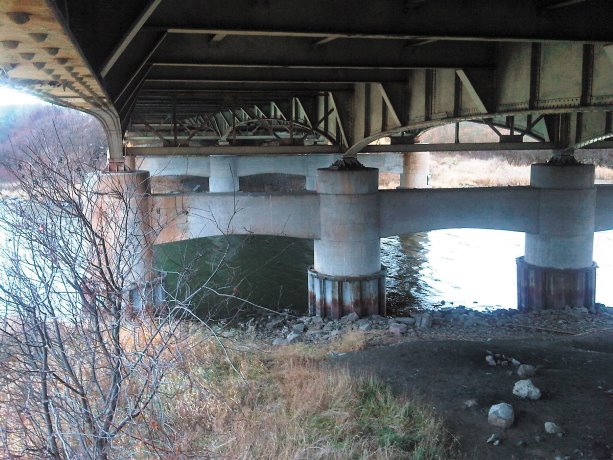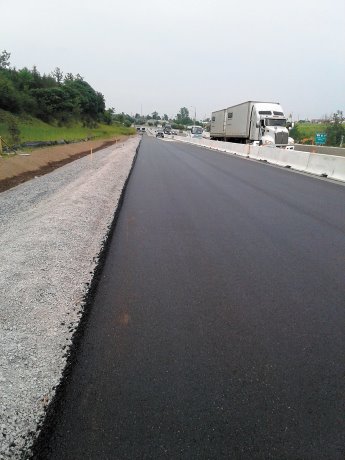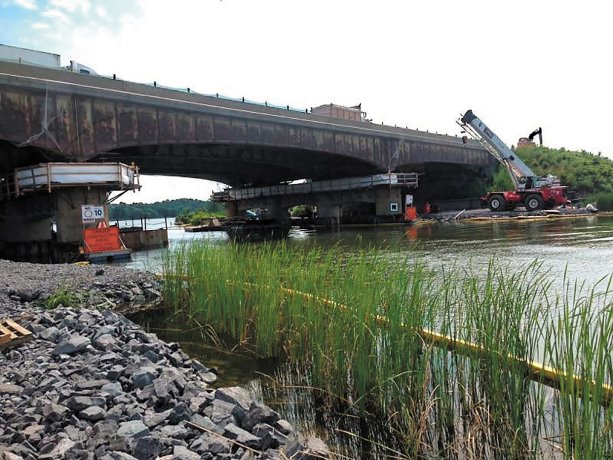One of only two bridges over the Cataraqui River in Kingston, Ont. is the centrepiece of a three-year $27-million project intended to improve traffic flow.
A long-time familiar sight to drivers on Hwy. 401 and boaters in the river — which is part of the Rideau Canal — the three-span, four-girder Cataraqui Bridge will be demolished and replaced with two longer and wider parallel bridges.
The demolition/erection is part of a widening of Hwy. 401 from just west of the bridge to the Hwy. 15 interchange.
Montreal-based Pomerleau Inc. is the general contractor in charge of the project, which also includes major improvements to that interchange. Work started this past January and will continue to 2020.
There were two consultants on board. The MMM Group designed the roadway portions of the contract, while the bridge was designed by the Ministry of Transportation’s own structural office.
More than 49,000 vehicles travel that section of Hwy. 401 daily and the Hwy. 15 interchange is the main route to C.F.B. Kingston a few kilometres to the south, says Ministry of Transportation contracts services administrator Pat Carroll.
"The Cataraqui River Bridge is 60 years old, has reached the end of its lifespan, and needs to be widened to accommodate the new lanes," says Carroll.
The new bridges will also be three-span steel structures but they will have 37 metre wide decks, which is 10 metres wider, and will also be longer at 117 metres compared to the existing 96 metre long structure. Wider spans are necessary to accommodate new pier columns that will be constructed further away from the navigation channel, which is the deepest part of the river, he says.
More than just the dimensions set the bridges apart from the existing one. They will have fully integral decks and abutments with expansion joints located outside of the approach slabs which effectively allows the necessary expansion and contraction relief.
"This is seen as an improvement to the way the existing structure was constructed," says Carroll, noting that the trend since the 1990s has been to eliminate expansion joints from above the abutment walls and making the superstructure integral with the substructure.
Removing the old bridge and installing the other two is a strategic and highly complicated procedure that started earlier this summer when Pomerleau erected temporary support beams underneath the outer portions of the bridge between the two outer girders, Carroll adds.
Saw cutting of the outer portions of the bridge, which is just underway, will create the space required to construct the outer halves of the new bridges.
And as those halves will be sufficiently wide enough to accommodate two lanes of traffic, vehicles will be shifted on to them once it’s built. Then the demolition of the remaining sections of the old bridge and the construction of the inner halves of the new bridges can begin, says Carroll.
Concrete barriers are in place to provide the safe movement of workers, materials and equipment to the work zones while maintaining driver safety.
But it isn’t just drivers that the contractor has to be concerned about. Working around and over the Cataraqui River without interrupting boat traffic is one of the most demanding aspects of the project.
Just north of the bridge are the Kingston Mills Locks which are open to boat traffic until the early evening hours. That means the navigation channel has to be kept clear during those times.
When work is required directly over the channel it has to be done at night, when the locks are closed or in the winter, he says.
And when that night work is taking place, the contractor sends out staff in boats to warn boaters from venturing too close to the bridge. Other safety measures include warning lights and the placement of barges, which also prevent accidentally dropped material from entering the water.
"They (the contractor) don’t want anyone near the bridge," Carroll states.
There is also close co-ordination between Parks Canada, which maintains the locks and Public Services and Procurement Canada which operates the LaSalle Causeway lift bridge to the south, says Carroll.
As for environmental protection, the waterway is protected by turbidity curtains that cordon off the necessary work area along the banks of the waterway on both sides of the navigation channel under the structure.
Further environmental controls are installed throughout the site such as silt fence barriers, straw bale flow checks and rock flow checks to keep sediment from reaching the waterway, he says.

1/2
Photo:











Recent Comments
comments for this post are closed